A revolution called Nautilus
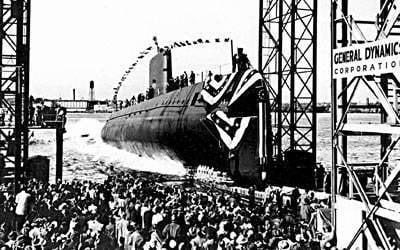
The first research work on the creation of a naval nuclear reactor (YAR) of the US Navy belongs to 1939. However, the events of the Second World War and the concentration of efforts of American specialists, as well as emigrant scientists from Europe with world-famous names A. Einstein, N. Bohr, E. Fermi , L. Stsilard and others on the implementation of the program to create the American atomic bomb (the Manhattan project) pushed the introduction of nuclear energy to the submarines for more than 15 years. However, even before the end of the war in the United States, a committee was created to develop proposals for the use of nuclear energy in the postwar period. Among them was the creation of the ship’s nuclear power plant (AES). In pursuance of this recommendation, by the end of the war, a group of officers and engineers of the Navy had been staffed at the Naval Research Center of the US Navy, which in 1946 took part in the construction of nuclear weapons in the Oak Ridge Nuclear Center.
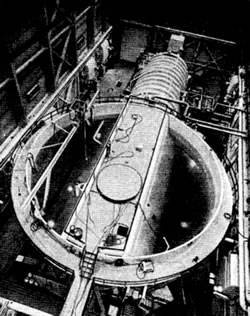 Ground Prototype AEU STR Mark I
Ground Prototype AEU STR Mark IThe group included electrical engineer Commander Hymen Rikover (1900-1986) - a man who played a crucial role in creating the first in the world Premier League Nautilus, as well as experimental nuclear submarines Tullibee, Norwhal, Glenard P. Lipscomb and serial combat nuclear submarines of the types Skipjack, Thresher / Permit, Sturgeon and the first Los Angeles sub-series. No wonder Rickover is called the "godfather" of an atomic underwater fleet USA.
However, at the end of 1947, the Navy’s shipbuilding administration did not support the recommendations of the group to accelerate the NR creation program with dimensions that allow it to be placed in the submarine hull and disbanded it. Meanwhile, work on the Yar for submarines continued and soon received support from the leadership of the US Navy. An atomic energy department was created at the Naval Shipbuilding Administration, later transformed into the naval reactor development sector of the Atomic Energy Commission (now the US Department of Energy).
By the end of 1949, the development of the project of the first ship-based NPP was completed. Energy engineers proposed to create a ground-based prototype of an NPP, and after testing it should ensure the placement of the installation on a submarine. From the very beginning, Project Manager H. Rikover demanded that the prototype reactor be placed inside a steel cylinder with a diameter of about 9 m - similar to the assumed diameter of the durable hull of the future submarine.
In July, 1951 Congress decided to build the world's first nuclear submarine. The Navy Department in December 1951 assigned the name Nautilus to the new ship.
Creating a ground prototype. In January, 1950 was decided to build a ground-based prototype for the STR Mark I - a thermal neutron reactor. Construction began near the town of Arco, in Idaho, in a desert area and far from large cities.
In February, 1950, Mr. H. Rickover, requested the leading US Navy shipyard Portsmouth Naval Shipyard regarding the feasibility of designing and manufacturing the YAR hull for the STR Mark I prototype. It was stipulated that all design work should be carried out under the direction of H. Rickover. When the shipyard management refused to accept such a condition, he offered this job to the Electric Boat Shipyard (Groton, Connecticut). At the end of 1952, the reactor vessel was manufactured and delivered to Arco. 30 March 1953. The prototype STR Mark I reached a criticality level, and 25 June of the same year, the installation was brought to its rated capacity.
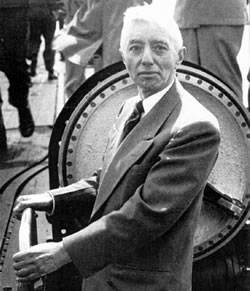 "Godfather" of the American atomic fleet Heimen Rikover
"Godfather" of the American atomic fleet Heimen RikoverSpecial attention was paid to the protection system. She was so sensitive that the reactor could be stopped due to the heavy sailor’s walk on the deck. Gradually, the number of safety parameters was reduced, and their permissible deviations from the norm were “coarsened”.
During the tests of the reactor after 24 hours of continuous operation at rated power, the engineers found that the data obtained were sufficient and suggested that the tests be completed. However, Rikover ordered to continue work in order to imitate the passage of a nuclear submarine with a full underwater course across the Atlantic: from Nova Scotia (a province in southeastern Canada) to Fasnet port in southwestern Ireland. The mode simulated a transatlantic transition of almost 2000 miles with an average speed of more than 20 nodes without stopping and ascent.
During the execution of this mode, there were several fairly serious emergencies. So, through 60 hours, autonomous turbine generators (ATG) actually became useless. Graphite dust formed during normal operational wear of their brushes has settled on the windings and has led to a decrease in insulation resistance. Several meters of the YAR monitoring system cables were damaged, as a result of which control over the core parameters (AZ) was lost. One of the two circulation pumps of the first circuit (CPNP) began to create an increased level of noise at high frequencies. After 65 hours after the start of the mode, the situation became even more tense. Several tubes of the main condenser were leaking. The pressure in the condenser began to rise.
Meanwhile, the experiment was completed. In general, the STR Mark I setting satisfactorily provided the 96-hour transition mode. During this time, the power was reduced twice to the level of 50% and once to 30%, but never the installation was taken out of action. Subsequent revision and inspection showed that all defects and damage were easily fixed.
Construction of the Nautilus submarine. The contract of the Navy with the shipyard Electric Boat was signed on 20 in August 1951. The laying of the Nautilus submarine took place on 14 in June 1952. During the construction process, the submarine weight load was strictly controlled. The cost of the submarine in 1951 prices was $ 37 million.
The boat was launched on 21 in January 1954. The “Mother of God”, which broke a bottle of champagne on its stem, was Mrs. Eisenhower, the wife of the President of the United States. 30 November 1954 The Nautilus submarine was incorporated into the US Navy. Commander Eugene Wilkinson was appointed the first ship commander.
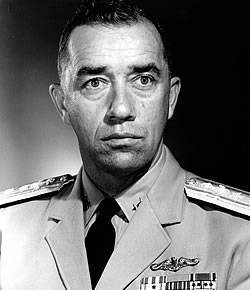 Eugene Wilkinson - the first commander of the Nautilus submarine
Eugene Wilkinson - the first commander of the Nautilus submarineUp until January 17, the 1955 of the APL continued to be located near the extension wall of the Electric Boat shipyard. Performed fine-tuning the ship to the design parameters. The most difficult was the provision of underwater autonomy, which was explained by the unsatisfactory operation of the regeneration and air conditioning system.
In May, the 1955, the boat passed under water from New London (Connecticut) to Puerto Rico 1300 miles for 84 hours. At the beginning of 1957, the permissible duration of stay under water was increased to 16 days (about 385 hours). And only at the end of 1958, the duration of uninterrupted stay under water reached the design value - 31 day.
The main characteristics of the Nautilus submarine: normal / submarine displacement - 2980 / 3520 t; length - 97,5 m, width - 8,5 m, height - 6,7 m, full surface / underwater speed - 20 / 23 knots; cruising range - 40000 miles (with YAR established during the second overhaul). Dive depth test - 213,4 m. The crew consisted of a 101 man, including 12 officers.
The boat had six nose torpedo tubes of type Mk 50 of caliber 533 mm for firing torpedoes Mk 14 Mod 6, Mk 16 Mod 6, Mk 16 Mod 8b and Mod 37. Shooting control system - Mk 1 Mod 3. Ammunition included 101 torpedoes (6 - in torpedo tubes and 24 - on racks). The submarine had an active / passive hydroacoustic station (GUS) of the type AN / SQS-6 with a cylindrical antenna in the nose. The detection range in echo direction finding mode is 18 miles, the operating frequency is 4 kHz.
The rugged Nautilus submarine hull is made of HTS steel and divided into six compartments with watertight bulkheads. The nasal extremity had stem poles, the aft - a conical shape with circular frames. For the first time, the whole crew was able to provide the crew with regular berths, abandoning the principle of a “warm berth”, when a sailor who had changed from the watch occupied any vacant berth, from which the berthing ship had recently risen. The foremen and sailors were located in the cabin with three-tiered beds, the officers in the cabins, the captain had a separate cabin. Living quarters were located in 2, 3 and 6 compartments.
Nautilus: “We go on nuclear energy”
The Westinghouse NPP included: one S2W type water-cooled reactor with a thermal capacity of 50 MW with two steam generators (PG) and three primary circulation pumps for each SG, two main turbo-tooth units with high and low pressure turbines with a total effective power of 15000 l. with., two main condenser, two propeller shaft with five-blade propellers. Biological protection YAR provided a decrease in penetrating radiation to a level below the natural background - about 3 rem over 30 years.
Operation of Nautilus submarines. At 11 a.m. on January 17, 1955, Nautilus gave the moorings at the pier of the Electric Boat shipyard and for the first time developed a course under the AEU. Captain Eugene Wilkinson sent become historical report: “Underway on nuclear power”.
Launching the submarine continued during the test. At the beginning of February 1957, the boat passed under the water 60000. miles During the 1957-1959. Nautilus performed various tasks, including four attempts to reach the North Pole. Only 3 August 1958 managed to do this when William Anderson commanded the boat. Submarine in 23 hour. 15 min. passed through the point of the North Pole at a depth of about 120 m under pack ice with a thickness of 7,6 m.
From 28 in May 1959 to 15 in August, the 1960 NPS underwent the first overhaul and reloading of AZ Yar at Portsmouth Naval Shipyard. From the end of October to the middle of December 1960 of Nautilus was in the Mediterranean as part of the 6 fleet of the US Navy. After that, the boat participated in a series of NATO exercises in the Atlantic. In the fall of 1962, the submarine took part in the naval blockade of Cuba.
Nautilus submarine enters New York harbor
From 17 January 1964 to 15 in May 1966, the second overhaul and recharge of AZ YAR took place. By the spring of the 1966, the submarine had passed underwater 300000 miles. Over the next twelve years, she participated in a number of Navy research programs.
It is noted that the unsuccessful design of the hull and superstructure of the submarine resulted in intense vibration. The effective operation of the HAS and the secrecy of the submarines were provided at speeds of only less than 4 nodes. This Nautilus lesson was taken into account in the development of subsequent projects of nuclear submarines, which received a more streamlined body shape.
Nautilus at the wall of the Museum of Underwater Forces
In the spring of 1979, Nautilus sailed from Groton to his last underwater journey to the Mare Island Naval Shipyard, where the ship was withdrawn from the fleet. Officially, 3 March 1980 was excluded from the "List of warships" of the Premier League.
Museum exhibit. In October, the 1979 of the Navy decided to convert Nautilus into a museum piece. In May 1982 was announced that the submarine is a "National Historic Landmark".
Conversion to the museum exhibit was carried out at the shipyard Mare Island. The core of the nuclear reactor was unloaded. Yar saved and preserved. For entry and exit of visitors in the right (front) board, two openings were cut in a sturdy housing. 1, 2 and 6 compartments are available for visitors.
In 1985, Nautilus was towed to Groton and placed in the waters of the Museum of Underwater Forces. 11 was opened to visitors of the Premier League on April 1986 on the day of the 86 anniversary of the establishment of the US Navy submarine forces. In 2002, the boat underwent a five-month repair on Electric Boat worth $ 4,7 million.
Every year on board Nautilus happens around 250000 visitors. Unfortunately, the fate of the first Russian nuclear submarine K-3 "Leninsky Komsomol" (see National Defense magazine for it, No. 12 for 2008), which they also wanted to convert into a museum, is still unclear.
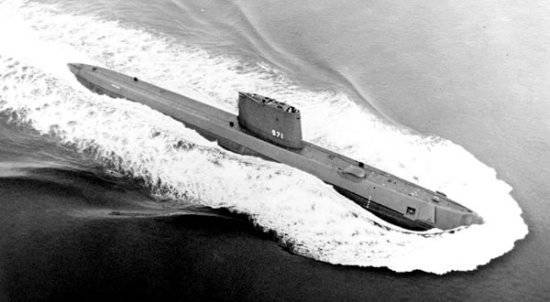
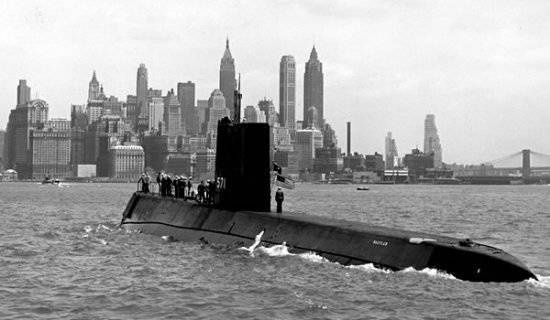
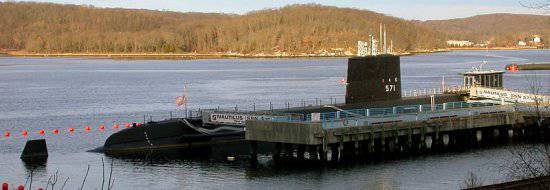
Information